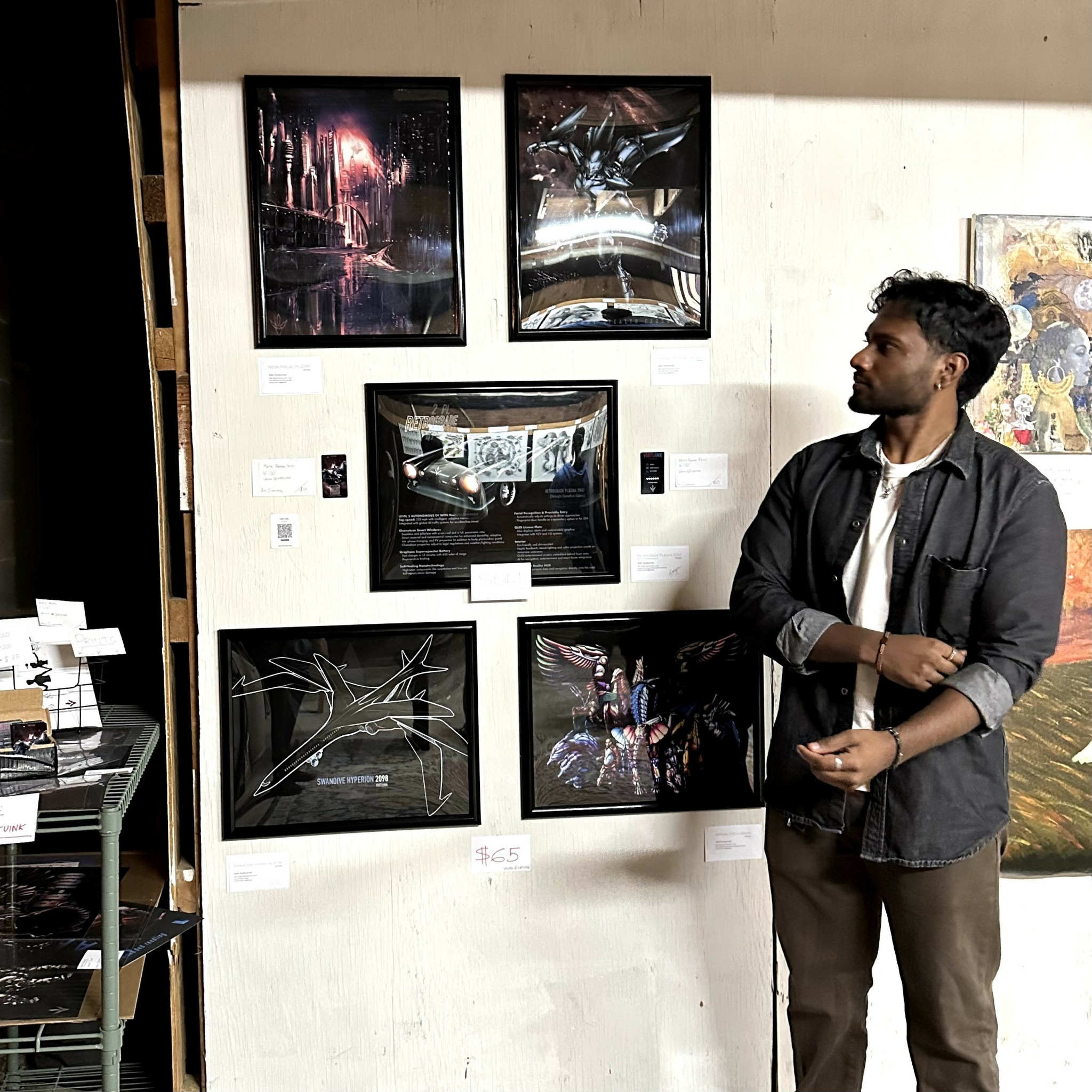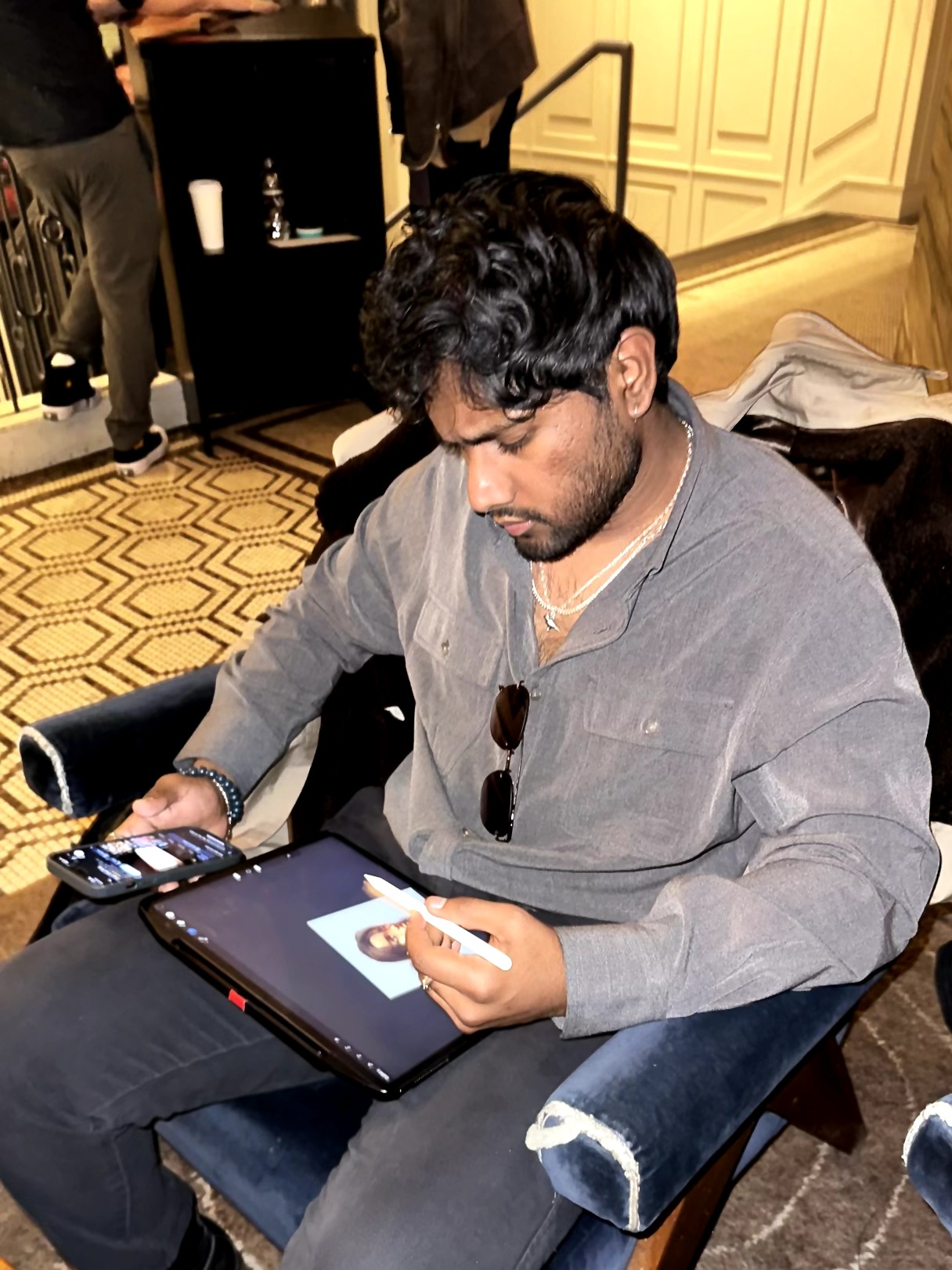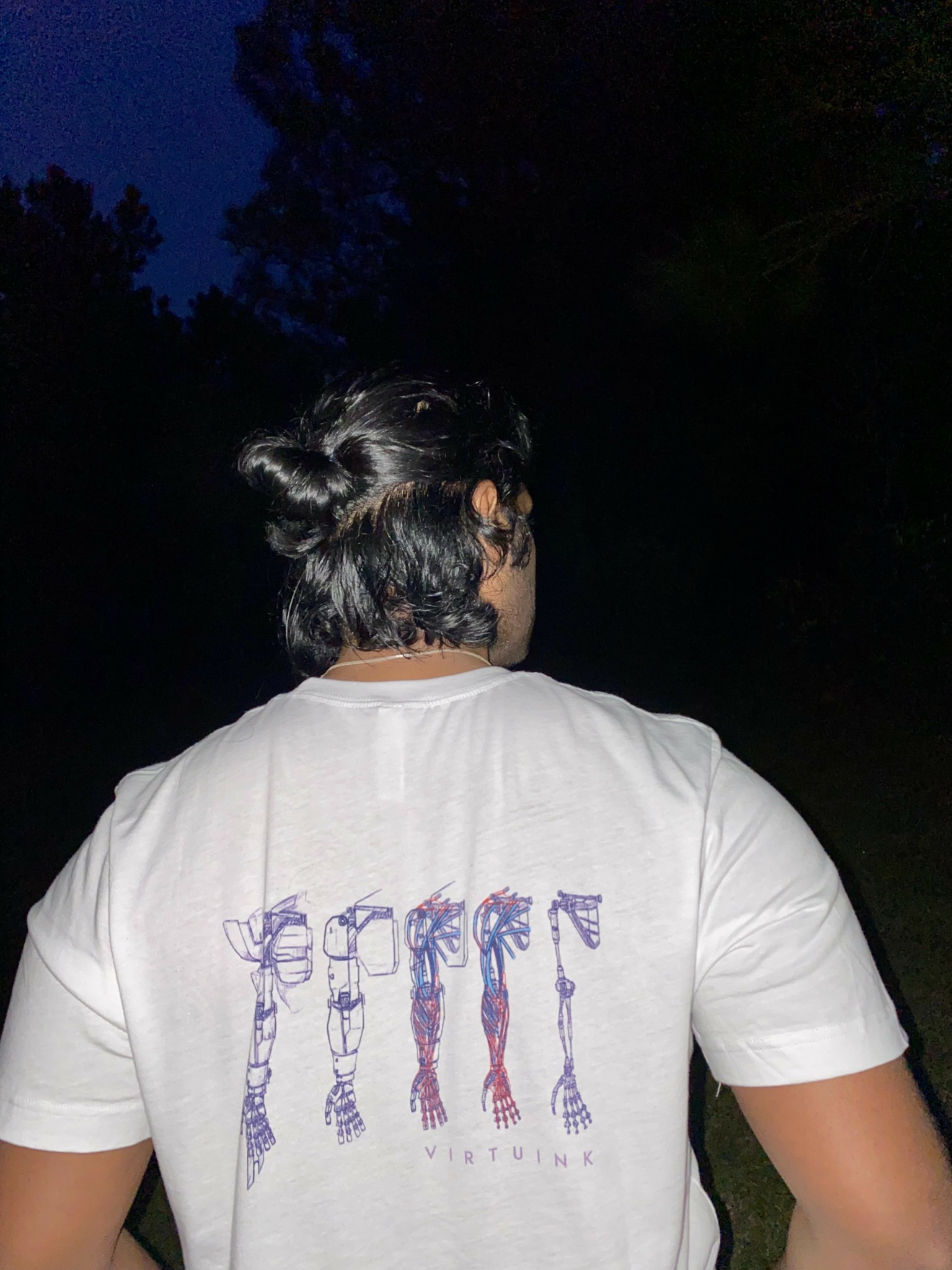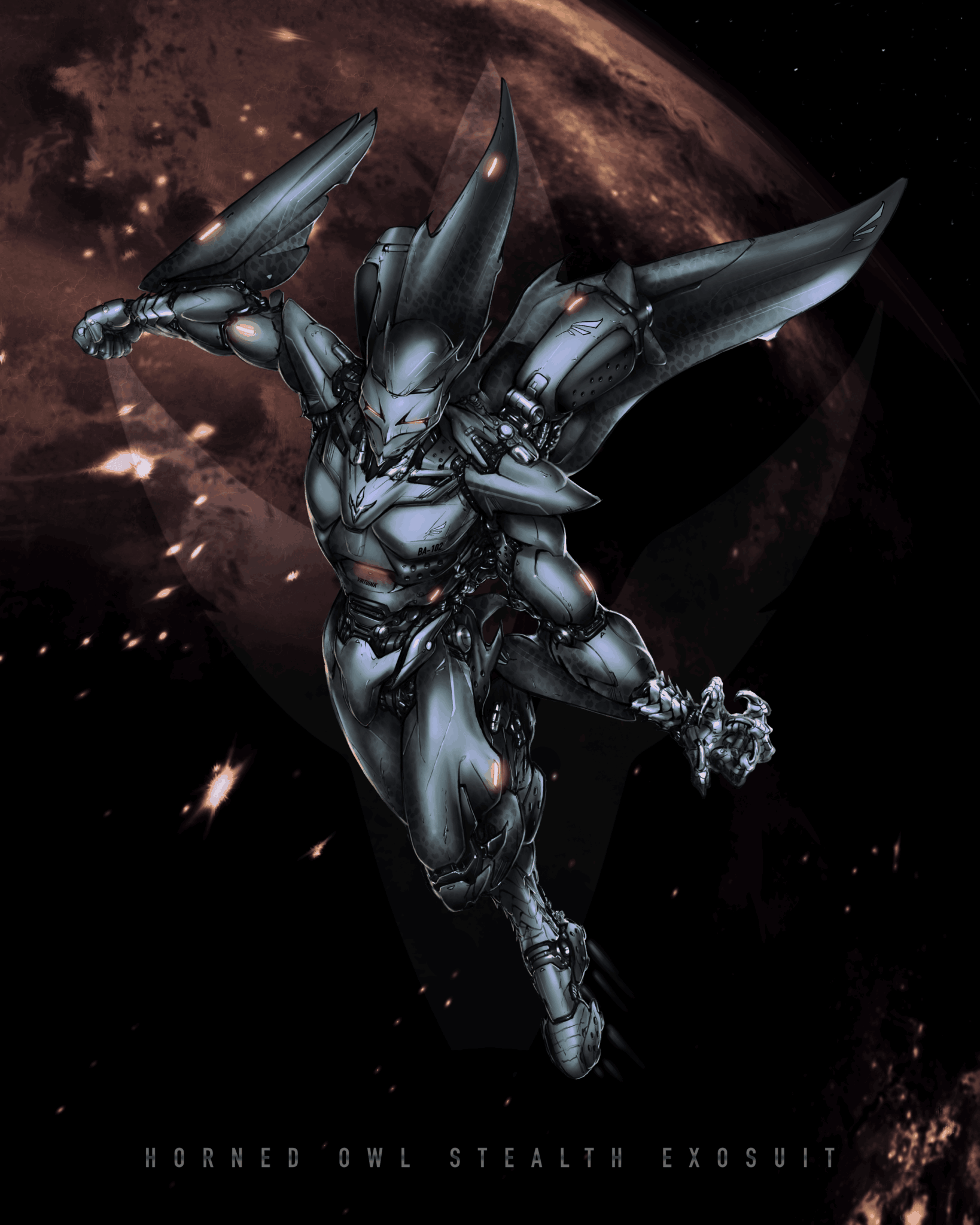Alright – so today we’ve got the honor of introducing you to Adiv. We think you’ll enjoy our conversation, we’ve shared it below.
Adiv, looking forward to hearing all of your stories today. Can you talk to us about how you learned to do what you do?
I won’t give you the typical response about the technical skills of a creative professional—because you can find that anywhere. YouTube. Paid and free courses. Books. Other artists on Instagram. Workshops. The list itself could probably wrap around Earth. So I’ll give you something that might be a bit harder to come by: a more philosophical response. Since I didn’t have much of a formal education in art or design, the philosophies I’m about to share were essential to my growth and overcoming mental obstacles. I discovered some of these things sooner than others, often in deep reflection, and if I’d applied them sooner, they would have notably sped up my learning process.
Yes, the fundamentals of art and visual design have obvious importance, but mindset carries just as much weight. And self-exploration can help you leave a unique mark, even when your designs draw from existing inspirations.
Reflecting on the abstract sequence that enabled me to grow as a creative professional, it might look something like this: inclination → imitation → curiosity → inspiration → exploration → passion → purpose → tenacity → persistence.
As a kid, paying attention in class wasn’t my strong suit. When I wasn’t daydreaming, I was doodling characters and creatures in the margins of my math notes, whether from my favorite cartoons or made-up concoctions from my imagination. Despite also having a firm grasp of subjects like math and science, I definitely had a strong artistic inclination. It felt natural and enjoyable, even though it wasn’t always easy (it still isn’t easy).
Those early doodles were the seeds of what I do now. I don’t think there was one specific thing that sparked that creative inclination. Maybe it was simply fun. Maybe it’s human nature; after all, pictures and storytelling are modes of communication that date back to our origins as humans. Maybe we all have some creative bone in our body, often in ways that aren’t limited to visual arts.
Nature itself creates, so it must be natural to be creative.
It might be a hot take to say anyone can be creative, but I genuinely do believe it’s not something only attainable or gifted to a select few; it’s a muscle that can be trained. My younger brother, who showed little creative inclination in his younger years, is a thriving creative professional and testament to this principle. The more I create, the more creative I become. My ideas and modes of execution evolve. This also translates into other aspects of my life as seemingly unrelated things begin to connect in my head. This mindset will enable you to pick up creative skills, form original ideas, and become more inventive.
While natural creative inclinations can give you an edge in the learning process of something like art, it’s a double-edged sword and not the be-all-end-all. Why? Because “talent” can breed complacency, while the not “talented” individuals who are hungry to learn and enjoy what they do will be the ones who can sustain the blood, sweat, and tears it takes to tread forward, failure after failure. In fact, I’d argue that the enjoyment of the process will give you better odds than “talent” itself, even though those two facets can sometimes play into one another.
So yes, inclination can kickstart the process, but it’s only the first step of many. And mindset? That’s the real game-changer.
As someone who loves learning, I also have an affinity toward science and technology. And contrary to popular belief, art and science aren’t inherently opposites; they enhance and complement one another. Design, especially, lives somewhere in that middle ground. Whether you’re building a new UI for a website, feasibly designing a car concept, or composing a color palette, there’s a dance between logic, creativity, and experimentation in it all.
Unfortunately, a lot of standardized education tries very hard to separate subjects like mathematics and art. But the more you question this, you see that art and design can be found in math and science, and math and science can be found in art and design. For example, the beautiful spiral constructed by the numbers in the Fibonacci sequence is used in artistic compositions that guide the viewer’s eye. And we also have the harmonious proportions of an architectural design, which still needs to be engineered in a way to maintain structural integrity. A painter making brushstrokes of mountains in the background may be aware of the scientific concept of atmospheric perspective, which involves the scattering and absorption of light by the Earth’s atmosphere. It’s why such mountains may appear washed out and often bluer as they go further away from the viewer. In fact, if you’re studying a subject—say anatomy—and there’s a test coming up, try sketching (it’s ok if you aren’t good) the parts and label them a few times. I can almost guarantee it will make the memorization easier and faster. Similarly, I guarantee if you study the science and math behind artistic decisions (such as the way sharp bends catch light or how geometry is applied in perspective art), you will have a firmer understanding of the world around you, accelerating your growth as an artist and designer.
This is why Da Vinci is my favorite historical thinker; he understood the marriage between art and science better than anyone. His genius enabled him to come up with concepts centuries ahead of his time. I believe that if the world structured its education with more emphasis around this marriage of creativity and logic and showed everyone that they can be creative, humanity would accelerate its development to incomprehensible levels. There would be far more innovation and critical thinking among the general population. The greatest minds and feats have in some way utilized this marriage between creativity and science—from the stylized rhythm and timing of Muhammad Ali floating around the ring to Einstein coming up with his breakthrough equations. If you didn’t go to art school like me, this mindset can help you learn quickly.
If you had trouble focusing in traditional classrooms like I did, then directing your own learning may also be your friend. Seek out your own resources. Let curiosity guide you based on your interests, on your terms. Knowledge helps creativity. Combined, they give birth to innovation. And pursuing knowledge and skills outside of your craft can help you grow as a creative because it can all connect. This is why I favor the jack-of-all-trades approach over hyper-specialization. If you’re excellent at one or two things and at least decent at a few others, I think that’s more powerful than being a one-trick pony. Sports, puzzles, reading, or picking up an instrument—these sorts of things exercise your ability to learn and will, by proxy, make you better at absorbing difficult creative skills. They can also form unexpected connections that make your ideas more original. Because it isn’t just about upskilling the craft; it’s about leaving your own unique mark. And sometimes, the other skills you learn will even directly help your craft. Networking, for example, helps creative entrepreneurship. I’m not the best at it, but this interview is one of the ways I’m putting myself out there to grow as a creative. Similarly, the boxing classes I’ve taken enabled me to paint a humanoid mechanical figure throwing a hook. Knowing and feeling the technique I’d practiced many times in the gym made the art way more informed than it otherwise would have been. I believe that the retained neuroplasticity from all that learning will benefit your ability to learn your craft.
Now, my bachelor’s degree is in computer science. And after a few years of delving deeper into art, I felt a pull to learn the skill of user interface design through online resources. I like how the field is grounded in structured principles and logic yet is creative and expressive; it applies visual design to software development. Remember that thing I said about seemingly unrelated things connecting? And how science can connect to art? Well, now I’m gonna connect both of those points to each other; here we have computer science connecting with artistic elements to form UI design, an example of both of those points in action playing into one another. Given everything I’ve talked about, it makes sense that I felt the pull to learn it. It wasn’t long before I added this to my offerings in VIRTUINK.
What began as a hobby in art has turned into a calling and, while humble and small, a brand I’m proud of. While I predominantly deliver artwork, I’ve also expanded to designing websites, apps, logos, apparel and print products, and other visuals—natural byproducts of my cross-functional learning. I also read up on science and tech and often bring pieces of what I learn into my speculative concepts. It all connects. Be careful with all of this though, especially if you’re an entrepreneur; don’t spread yourself too thin. Outsource what you don’t have time to learn. Perfectionism will also slow you down. Get things done; refine later if you need to. It’s gotten me before but I’m learning to fight it. It pained me to release my portfolio site without the robust functionality I wanted, but I had to prioritize other projects. I still put in the effort to get things to a solid stopping point: high quality but not perfect, and man, scratching that goal off the list was satisfying. My pivot also enabled me to work with more clients and make important progress on my other goals this year, allocating the portfolio as something to revisit.
The few times my work has been featured in a gallery or installation, a frequent compliment I’d receive was that my work was unique. Sure, there may be plenty of artists who have dedicated their lives to mastery of their skill (leagues above my skill), and there are artists far more skilled than even them, but all of us have at least one thing we can do: find a way to be unique. This brings me to my next point to succeed in creative endeavors: you can never be the best, so be different.
Don’t mistake me—you should always aim high. But unless you’re in a literal competition, fixating too much on being the alpha standing on top of others can be a fatiguing balancing act. There will always be someone “better”. Still be healthily competitive, but focus more on being the best version of yourself rather than on comparison. Too much of it can stifle your growth and demoralize you. In fact, even if you were handed the title of “the best,” this entails the added pressure of maintaining that until you lose your balance and fall. You’d essentially be worrying too much about where the people right under you are rather than focusing on yourself and your goals.
I’d argue you will derive more satisfaction from making your own unique mark and fostering community spirit rather than only competing with peers in the same field. You’ll also learn more because you’ll be helping one another. After all, the best way to learn is to teach. So you should try to think positively about people’s successes because they are showing you it can be done, and, depending on the person, how. It’s not always an easy thing to feel when you’re struggling, but it’s a good thing. Instead of thinking: man, how did that person achieve this and that? It’s not fair, etc., reframe it. Think: man, they did it. Good for them. It’s been proven possible. That motivates me. Let me learn from it and give it a shot. If it’s been done, it can be done. Such mindsets can help you position yourself with an attractive energy to your goals. Plus, if you like looking up at the stars and thinking bigger: more people achieving through good work benefits humanity as a collective.
There’s always at least one person who cares, so there can be more. While reach and growth matter, the quality of the audience matters more than quantity. While having more followers for your products and services is a goal, having 200 followers that love your stuff is better than having 2,000 that don’t see it as their cup of tea. At the end of the day, which translates to clients and collaborators, and which enables you to make your unique, positive impact? The ones that want to be impacted. Your art may be technically exceptional, but that doesn’t mean everyone’s gonna love it. Focus on fine-tuning your process, goals, and catering to your target audience. Those who appreciate your hard work will find you—and you will find them. Do it for them. Do it for yourself. And stay on that path, growing your network and seeking out opportunities.
On this creative journey, whether personal or professional, you will stumble. You will fall. But if you keep at it long enough, you will find purpose.


Adiv, before we move on to more of these sorts of questions, can you take some time to bring our readers up to speed on you and what you do?
My formal art education was minimal and patchy—a few standardized K–12 art classes and a college minor in art. But I won’t deny that a more focused, in-depth formal education is often the most surefire and structured way to learn art or design. Unfortunately, not everyone feels that they have the luxury, desire, or time to go that route. Originally, my college minor was in math. But I felt an instinctive pull to incorporate more creativity in my learning. I had plenty of math included in my existing CS curriculum, so I followed my gut and switched to studio art. Looking back, I learned: when your creative spirit is clawing to release itself and you feel it—let it out. Ultimately, you can choose to either feed your soul or let it eat at you. And for many years, I believe it did the eating because I didn’t give it enough attention. While most of my skill is accounted for by self-directed learning, those bits of standardized education definitely did give me designated time to realize my interest in creative work—whether it was a digital painting class in high school or Art Fundamentals 1 in college. Little did I know each step was building toward a pivotal decision in my future.
I decided, within the years after graduating university, to forge a path compiling my own resources, research, and self-directed learning. My self-exploration started sometime in 2019. I noticed artists online drawing on tablets, which reminded me of the digital painting classes I took. So I was tempted to get a tablet for myself. One of the reasons I didn’t practice art enough until that point was my own laziness; it was too much to learn, too many supplies, and too time-consuming. In my ignorance, I also didn’t see it being fruitful or useful due to the negative stigmas around it as a profession. But now, I had no excuse to continue being lazy. All I had to do was bust out the same portable tablet and Apple Pencil every day and get to work. With the added convenience of technology, I couldn’t fight the urge to test my limits and figure things out. And that feeling exists to this day.
So it began—late at night, alone with that iPad—figuring things out by trial and error. That kind of untethered exploration taught me things in a way that perhaps an institutional curriculum wouldn’t have. I certainly felt more freedom than sitting in a classroom. But the biggest thing it did for me was help solidify my interest. What started as inclination and imitation of cartoons as a kid was now rekindled as curiosity, inspiration, and exploration as a young adult. When I began to experience the well-known phenomenon of newbie gains, my improvement and the process of creating pieces became addicting. This continued into 2020 during the COVID-19 lockdowns. I had more time to delve into my craft. In the painful boredom of not being able to leave home much or socialize, I passed the time by watching shows when I wasn’t drawing. I stumbled upon the Gundam franchise. From the instant I saw the intense mecha battles on screen, I was impressed by the level of detail in the mechs. I’d never really seen anything like it before, as I’d never explored that niche. But it still evoked a nostalgia for the animated shows I watched growing up. Not knowing nearly as much about art and design at the time, I wondered: how did they design these concepts? And how on Earth are they able to animate this type of stuff? It looks so sick. I wonder if I could draw something similar. These thoughts are the rough point of origin for the type of artwork I produce today.
The sci-fi genre and mecha niche, with its complex designs and themes, inspired me to try making my own mechanized artwork. It had been a long time since I was a young boy doodling imitations of what I saw on TV or making up my own concoctions. I felt like I was revisiting that side of myself, but with a more sophisticated and challenging edge. I began by creating mechanized versions of animals, and with each one I saw new improvements. I paid attention to my techniques and things that I noticed other artists do, but I always sought to retain the uniqueness of my own concepts. As I began posting on various platforms, I gained some traction.
People often tell me that my work evokes a nostalgia for shows they watched growing up (like Digimon, Iron Man, Yu-Gi-Oh!—the list goes on). Many of the things people told me my work reminded them of—like Zoids, Macross, or random video games—I’d never even seen or heard of. But to know that I was able to rekindle that sensation they once felt—that was huge for me, and it continues to keep me going. It wasn’t long before I gained commissions and referrals, and what was once a light hobby turned into a passion and purpose.
When you examine my work, you might notice it blends that nostalgia from many inspirations—including sci-fi works, video games, and animated series—with original designs that invite you to explore the unknown. My fascination for speculative and futuristic worldbuilding bleeds into everything I create, usually taking on a dark sci-fi aesthetic. Whether I’m designing mech concepts, vehicles, characters, or dystopian landscapes, my goal is to evoke a sense of mystery, potential, and awe. To me, art is more than aesthetics—it is a tool to form connections and synthesize new ideas.
Beyond my artwork and original concepts, I’ve collaborated with clients across industries, designing logos, websites, tattoo templates, cover art, and more—each project infused with my distinct vision. No matter the project, I strive to craft something unique, immersive, and visually striking. I’m fascinated by topics in science, technology, and philosophy, and I let them influence my work. I am a firm believer that understanding the world around you enables you to be a better artist—and in turn, improving your design and artistic skills helps you understand the world from fresh angles. That’s one of the things that keeps me pushing forward, and I warmly welcome you to be a part of that experience.


Learning and unlearning are both critical parts of growth – can you share a story of a time when you had to unlearn a lesson?
It’s not pointless. It’s not useless.
With my background, titles like doctor or engineer were what held prestige in the community. Those paths seemed to define success. But honestly? If I could go back, I’d have started taking my craft seriously much sooner. For the longest time, I treated creative work like an occasional hobby and avoided going deeper into it. Society had convinced me it wasn’t a “real” path. Fun? Yes. But viable? No. It wasn’t until the last five or six years that something in me shifted, and that’s when I saw the most growth as an artist and designer.
In trying to take it seriously, make it professional, and truly see the value in it, I had to unlearn a lot. I adopted the philosophies I talked about earlier, and those mindset shifts helped me recognize the importance of art and design. I actually feel motivated in my own work.
Hopefully, anyone with similar misbeliefs will begin to consider the meaning and soulfulness that creative work can exude. Art and design benefit everything, even the very fields that are typically seen as more prestigious. Try reading a medical textbook with no pictures or diagrams; it’d probably be five times harder to comprehend without visuals. They say a picture is worth a thousand words for a reason. So yes, art has helped that surgeon operating on your knee.
And imagine every piece in your wardrobe stripped of its flavor, reduced to bland cloth used only to cover us up. What we wear plays a role in how we feel about ourselves and how we’re perceived by others. Without it, our individuality would starve.
I thought art was useless, not acknowledging that even animals create, from the collage of bird’s nest to the sculpture of a beaver’s dam. Even nature is as much a designer as it is an engineer. The function of art and design isn’t always obvious because it often serves nuanced purposes beyond basic utility. But it arguably supports one of the most important things, something that underpins everything we do: our psychology. Without it, we wouldn’t be ourselves.
Such mindset shifts also helped me work through common obstacles: imposter syndrome, lack of guidance, time constraints. Once I dropped the baggage of my misbeliefs and embraced the process—mistakes and all—I found momentum. And when I began to value that side of myself, others started to as well.
None of this is to say that everyone needs to turn their creative passions into a profession. Not everything has to be monetized. It’s completely valid to keep art, design, or any creative outlet as something that exists just for you, for joy, for healing, for expression. While it can have a client or customer, it doesn’t need one to be meaningful. If it nourishes your mind and spirit, that’s one reason to keep doing it.
All of this: my art, my design, my mindset—it’s very much a work in progress, and I still have so much to learn. But I’m excited to see what’s up ahead.


Is there a particular goal or mission driving your creative journey?
I am driven to captivate and inspire through visionary art and design, pushing the boundaries of my imagination to create unique visual experiences. Through VIRTUINK, I share my creative journey to entertain, inform, and ignite curiosity, connecting deeply with those who seek to escape into my rich, speculative world.
My content, products and services are all geared toward this mission.
Contact Info:
- Website: https://virtuink-portfolio.wixstudio.com/virtuink
- Instagram: https://instagram.com/virtuink
- Facebook: https://facebook.com/virtuink
- Twitter: https://x.com/virtuink
- Youtube: https://www.youtube.com/@virtuink
- Other: https://tiktok.com/@virtuink
https://pinterest.com/virtuink
https://reddit.com/user/virtuink




